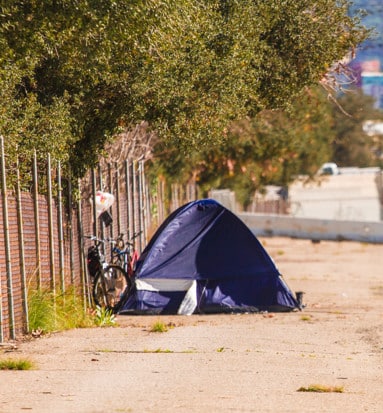Given the housing crisis in Greater Montreal and the alarming increase in visible homelessness, Centraide is firmly committed to tackling these two critical issues. For example, Centraide invited partners to the Together for Housing event to come up with sustainable solutions to this problem. Centraide also swiftly responded to the perfect storm of homelessness by establishing new collaborations and significantly increasing its investments in this area over 2021.
More and more people are finding themselves in a situation of homelessness on the streets of Greater Montreal and in its parks, underneath its overpasses, and in its shelters—an alarming situation that raises crucial questions about social exclusion.

Homelessness is the most extreme and obvious form of social exclusion. Finding yourself in this situation means being excluded in many ways: from work, from housing and from family.
Revisit our post on social exclusion.
The paths that lead people to homelessness are varied and result from complex problems that often begin in childhood or that develop in different stages of life. In many cases, homelessness comes with mental health or addiction problems.
Risk factors for homelessness
- Family problems
- Marginalization and social exclusion
- Low income
- High rent costs and housing shortages
- Difficult immigration experiences
- Mental health problems
- Alcohol and drug addiction
- Violent relationships
Being evicted from their homes and having trouble finding a new one are the top reasons people end up on the street.
The vision of Mouvement pour mettre fin à l’itinérance à Montréal
That all people in Montreal who have experienced chronic homelessness have access to housing; that all people in Montreal who find themselves in a precarious or homeless situation have access to immediate support; that all players collaborate and coordinate their actions to support people experiencing homelessness or precariousness.

Exploding numbers
The population of people experiencing visible homelessness in Quebec has been counted three times over the past ten years.

Homelessness is no longer confined to downtown Montreal and has spilled over into many Montreal neighbourhoods as well as into Laval and onto the South Shore.
The Island of Montreal has the highest number of people in a situation of homelessness in Quebec, as 47% of the 10,000 people included in the count live in this region. The South Shore saw the biggest increase (98%) between 2018 and 2022.

And these numbers don’t even account for invisible homelessness.
RAPSIM’s position:
“The count gives us just a snapshot of visible homelessness at a given time in Montreal. Like any photo, some details are missing from view: the context, hidden homelessness, seasonal fluctuations, mobility, etc.”1
Two faces of homelessness

Visible homelessness
This type of homelessness is when people live in improvised shelters or abandoned buildings. It also includes those staying at facilities or resources for people experiencing homelessness. Visible homelessness can be cyclical, i.e. when people alternate between living in a home and living on the street. Chronic homelessness refers to people who haven’t been housed in a long time.

Hidden homelessness
This type of homelessness is when people sleep in their cars, couch surf at a friend’s place, or live with multiple people in an apartment. This phenomenon also includes living in short-term housing such as rooming houses or motels or being forced to stay in an abusive or violent environment.
Revisit our post on hidden homelessness.
Observations from the field
- Shelters and housing centres everywhere are seeing the same thing: the homeless population is getting older.
- The proportion of women experiencing homelessness is rising, reaching 29% in 2022 compared to 23% in 2018.
- Indigenous people, men, 2SLGBTQIA+ youth, young people who have been placed in care by the Director of Youth Protection, and people who have served in the Canadian Armed Forces or the Royal Canadian Mounted Police are over-represented among those experiencing homelessness.
- On the Island of Montreal, the population experiencing visible homelessness is older than in the rest of Quebec and proportionately includes more immigrants and asylum seekers. What’s more, these people can face longer periods of homelessness that often exceed one year.
- 70% of people experiencing homelessness on the island of Montreal are concentrated in five areas: the Ville-Marie borough, Plateau Mont-Royal, Mercier-Hochelaga-Maisonneuve, Le Sud-Ouest, and Côte-des-Neiges-Notre-Dame-de-Grâce.
Daily challenges for people experiencing homelessness
- Finding a safe place to sleep
- Fighting the cold in winter
- Getting something to eat
- Accessing public washrooms and other facilities
- Managing mental and physical health problems
- Obtaining health and social services
- Fighting discrimination and stigmatization
- Sharing public spaces
Centraide’s support
About thirty community agencies supported by Centraide work to prevent homelessness and mitigate its effects.
Our investments are based on diverse strategies with agencies that offer:
- Prevention services
- Daytime and nighttime services
- Psychosocial services
- Street and community outreach
- Social coexistence services
- Advocacy and defence of rights
- Training for staff
Getting back on track thanks to housing resources
Philippe had a good life with his wife and two children before depression took everything away. He lost his job and then his family, his belongings and his apartment. La Casa Bernard-Hubert helped him get back on track, feel at home, recover from depression, and take back control over his life.
Discover the Phillipe’s testimonial.


Homelessness in Montreal: Second edition of “beyond the numbers” report
This collective work coordinated by the Réseau d’aide aux personnes seules et itinérantes de Montréal (RAPSIM) was produced in collaboration with 38 people from the homeless community. Through 20 portraits, the report describes the geography and themes of homelessness in Montreal in 2023.
Read it here (in French only)
Note :
1. Réseau d’aide aux personnes seules et itinérantes de Montréal (RAPSIM) (2023). L’itinérance à Montréal : Au-delà des chiffres – 2nd Edition. https://rapsim.org/au-dela-des-chiffres-revue/
1 out of 5 people receives our help.
5 out of 5 people benefit from it.
Let’s all lend a hand
Supporting a network of over 375 community agencies also means promoting an inclusive, poverty-free society.



